Training for Surfers to Breathe Better… It’s Important…
Breath Training. Your life depends on it. Literally.
This rings especially true for surfers.
If you’ve ever been in a hold-down situation, you know the fear, the anxiety, and that instinctual need for breath that kicks in. The freaking out, the chaotic kicking and paddling for the surface, all of which does nothing good for the situation.
You need to learn to breathe better.
It will help your paddling, help you in hold down situations, and improve your overall health. But it must begin with the fundamentals of breath. Baby steps before copping 8 foot closeouts on the head.
In November of 2016, I went to G-land for the first time. Everything you’ve heard about the place is true. It’s absolutely incredible.
Check out Damien Hobgood’s Wave of the Winter.
Long story very short, the place is epic, truly epic. My second day surfing it was a 6-8foot day, and a bit shifty. Some absolutely proper sets, maybe pushing past that 8foot range. Definitely exceeding my level of comfort has been basically the first time I’ve ever surfed it.
Before I ramble, what ensued was me copping a PROPER beating from a PROPER wave.
A full set wave pushed in, easily 8 foot, I tried to scrape into it, realized I wasn’t making it, tried to pull off the back and threw the board over….. and the laws of physics and vortex forces sucked me right over into oblivion. I managed to get a Giant Inhale (read the article) and proceeded to get flogged, but relatively stress-free.
As you can guess, I proceeded to cop about 6 more solid ones on the head, with some breath recovery strategies I learned from Nam Baldwin (BET Training), in between waves, and some more Giant Inhales prior to going back under.
You could call me on bullshit, but the funny thing is there were witnesses! I made it back out to the lineup, got my wits together, scored some nuggets, and eventually went in.
My girlfriend and a buddy both told me about seeing a guy (me) catch an absolute atrocity of a beating from the beach, and another buddy in the lineup was dying, said he watched me from the back getting sucked over. HAHAHA! Anyways, this breath stuff, it works. So apply it.
Breath – Potential Effects on Physiology
All those arrows (pic), they’re all potential downstream effects that “bad” breathing could cause to the human system. They’re all detractors from performance, and from health. Train to breathe better. It’s not difficult.
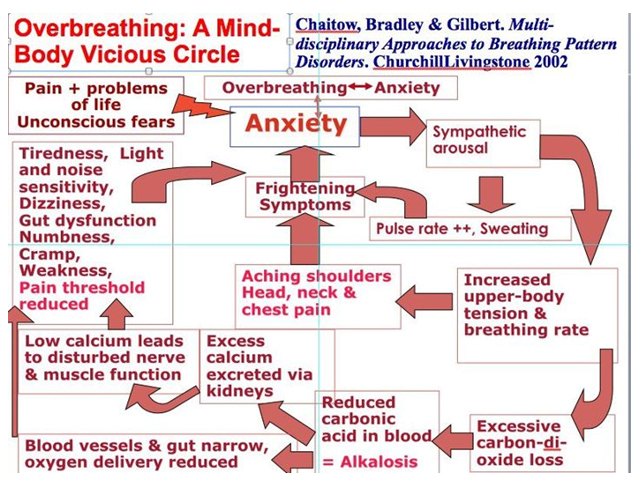
Breath is something that should be trained, but often goes neglected. That neglect is unfortunate, as the benefits of breath training extend much further than the simple ability to hold your breath for longer under water.
Although, anyone that has been in that hold-down situation knows it doesn’t feel like some “simple ability”, it feels like the only importance in the world.
The Nervous System – Sympathetic & Parasympathetic Branches
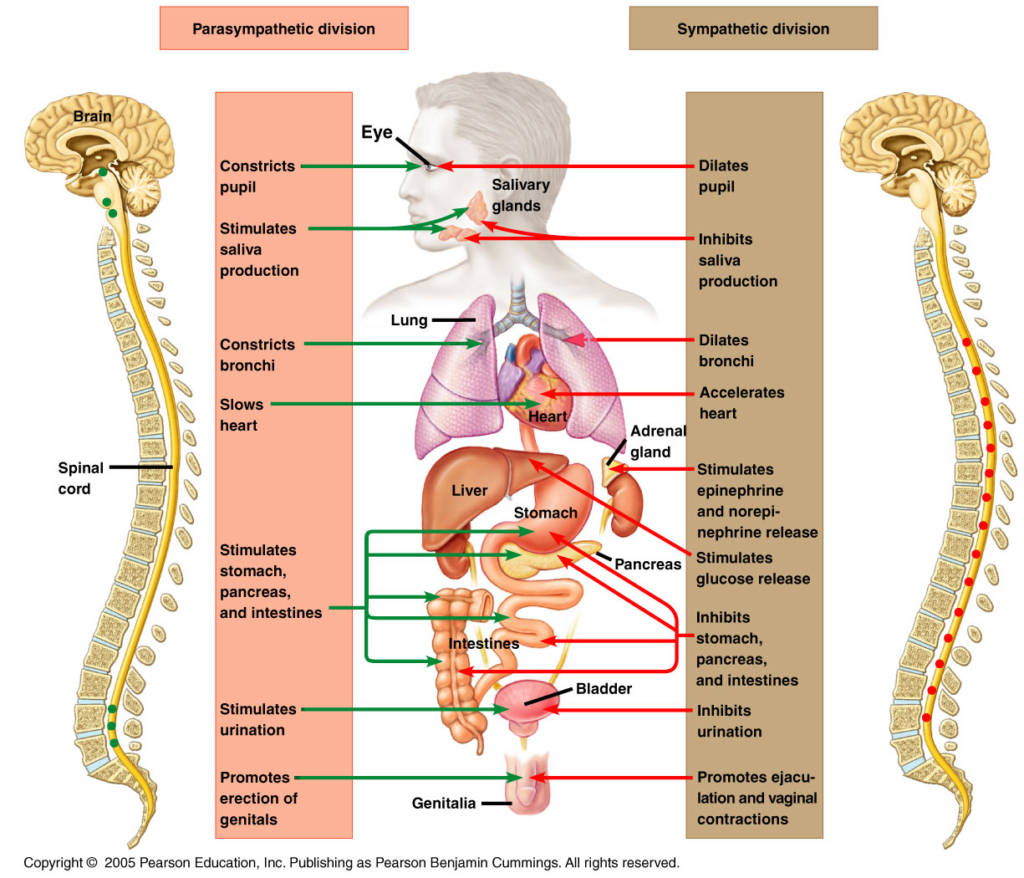
Breath is the quickest way to tap into the nervous system. It can add stress to your system, increase the heart rate, increase alarm signals throughout the body, or conversely, it can be calming, slow down the heart rate, help you to focus, and increase alertness.
The breath can quickly shift the nervous system towards the sympathetic fight or flight state, or the parasympathetic calm and restorative state. Which of those do you think will increase Oxygen consumption? (sympathetic) Which would decrease the heart rate and lower oxygen consumption? (parasympathetic)
The ability to hold your breath, stay calm, and relax, could literally save your life.
But it all has to start with the basics of quality breath.
Quality Breath – The Basics Of Surfing Breath Training
What is a “quality breath”? Before you can explore any details of breath enhancement training, you need the ability to simply breathe efficiently. So what does that even mean?
Diaphragmatic Breathing. (pic – diaphragm muscle sitting underneath the lungs)
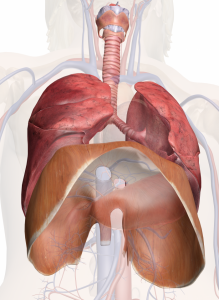
If you’ve ever taken a yoga class, you’ve likely heard this term. It simply refers to breathing with your diaphragm as the primary driver of the breath. As the diaphragm contracts down into the stomach, it creates a negative pressure in the lung cavities.
This negative pressure then pulls air down into the lungs, so that the oxygen can do its life-giving thing around the body. You’ll hear this referred to as “belly breaths” or “Buddha breathing”, as those terms refer to the expansion of the stomach upon inhaling.
This misses the boat just a bit though, as people can cheat this, and simply push their stomach out with a muscular contraction, rather than it happening reflexively from a descending diaphragm.
Neck Breathers…..
The majority of people, through stress, injury, neglected posture, blocked nasal passages, and emotional or mental trauma, have shifted to what is termed “neck breathing”. This means you’re using secondary respiratory muscles of the neck and shoulders to be the primary drivers in breathing.
This creates a lot of unnecessary tension and strain in those muscles, that are already being used to paddle while surfing.
Neck and Shoulder Tension While Surfing…..
Do you already have neck and shoulder tension? Add to that a few thousand neck breaths every single day and it exponentially worsens the situation. Not only is this neck breathing pattern inefficient for your physiology, as well as oxygen and carbon dioxide exchange, it also makes it near impossible to paddle efficiently as you could in the surf.
Most importantly with hold downs, that neck breath makes it damn near impossible to get full breath in before being thrown into oblivion by a set.
Stand in front of a mirror. Take a breath in. Did most of the movement come from the neck? Then you’re a neck breather. Don’t feel bad, you can change it, and if you have any intention to surf better, prepare your body for hold-down situations, and maintain a healthy neck and shoulder girdle, you should change it.
That neck movement you most likely saw should only be about the last 10-30% of inhalation. The primary portion of the movement should be rib expansion in all directions, expansion, and elevation of the chest, and lastly coming a bit into the neck. Lastly is the key word here, not firstly, and not primarily.
Neck Breathing and Copping Sets on the Head
You’re about to catch a 6 foot set on the head. You’ve already been spun underwater for about 10 seconds on the last wave, you’ve just gotten to the surface, and you see the next set wave about to pummel you. Your heart rate is up, and you’re stressing out.
You take a shallow neck breath in and prepare for the next hold down. This is 100% inefficient. You are putting yourself in danger. You can and should do better.
That shallow neck breath is only getting about 20-40% lung capacity filled. That’s not a good thing when you’re prepping for a punishing hold down. That neck breath is also sending alarm signals to the nervous system, which in turn increases the heart rate, and burns up oxygen. These aren’t good things for your hold down.
If you’re in a stress situation, you’ll revert back to whatever breathing pattern is habitual. It’s likely that a neck breath is habitual for you, and it’s nowhere near efficient or beneficial for your surfing.
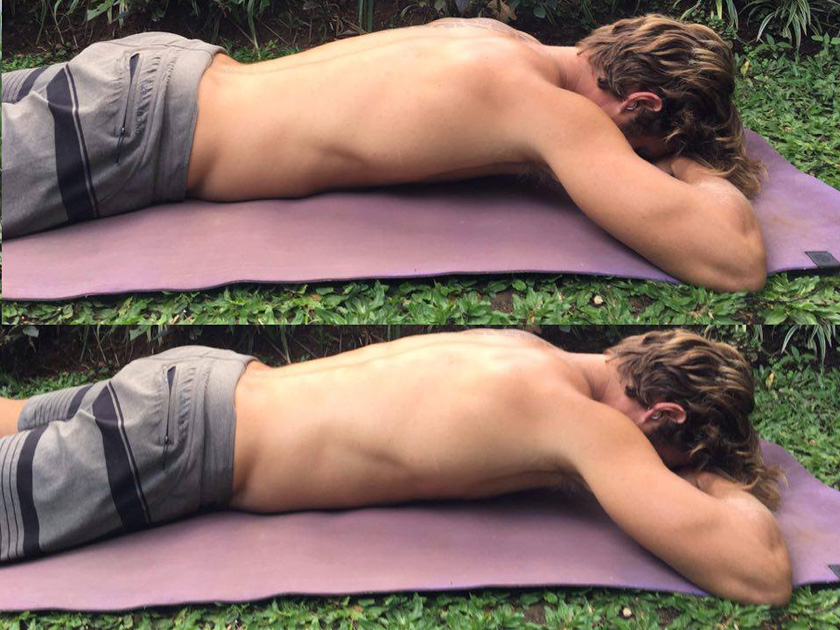
Practice Diaphragmatic Breaths… Lay on Your Belly
Lay on your stomach. Breath into the floor and low back. Slowly. See if you can get into that 3-dimensional expansion. Posterior expansion (breathe into your low back), lateral expansion (breathe into your sides), and anteriorly (upper stomach presses into the floor).
It’s the expansion of the rib cage because the diaphragm is contracting. That’s the key. Driving inhalation from diaphragmatic contraction, not simply sucking air in with your neck muscles.
Then slow it down. Get rhythmic. Get into box breathing rhythms. 3-4 second inhale, 3-4 second pause, 3-4 second exhale, 3-4 second pause. Slowly and rhythmically continue doing this, with a focus of breathing into your stomach and low back. Really feel that expansion of the stomach.
Don’t force it, allow it to happen because the lungs are filling with air. Relax the neck. The floor pushing back against your stomach will give you some tactile feedback of belly breathing.
Once you’ve gotten that down, lay on your back and continue. If you need more tactile feedback, place your hands on your belly. Breathe into those hands. Relax the neck. Feel your low back lightly expand, feel your stomach raise up, and feel your ribs expand laterally. The neck is the last to move. This is where performance breathing starts. Creating the habit of effective breath in a non-stressful and relaxed environment.
And More Practice
Another good aspect of slow rhythmic breathing is that you’re working on improving the C02 tolerance of the body. This is governed by your brain stem (pons and medulla oblongata), just think of it as a thermostat.
If you can shift that thermostat to having a better tolerance of more C02 in the blood…. well correlate that with being held underwater and accumulating carbon dioxide in the blood stream. Yeah, it’s a good thing.
If you can’t breathe well in a perfectly relaxed setting, you’re not going to breathe well when you’re catching a 6foot set on the head.
This type of slower rhythmic breathing can lead into meditation if you’re interested, which has shown numerous benefits for overall well-being. Clearly, it’s a good thing.
Listen to this video (below) and work on box breathing. Really slow down that box breathing tempo, getting towards 8-10second inhales, exhales, and pauses. Don’t force it, allow it to happen over time, let the body zen out and get parasympathetic.
This video is a binaural beat audio video. It’s been shown that binaural beats can help to sync brainwaves to “calmer” states and bring about more theta or delta brain waves. **you have to listen through headphones.
Binaural Beats – Listen and Be Zen
https://youtu.be/NhJpV11spJU
Practice Makes Habit. You’re training a new breathing habit. Work on it, so that when you’re in a stress situation, you’re not reverting back to shallow stressful neck breaths. Start with the laying variations, and then begin to check in on yourself throughout the day. How’s your breathing?
The Giant Inhale
Putting it into action is a giant inhale prior to a wipeout. That basic understanding of how to breathe without using only those over-used neck muscles is the key.
Now to get in a giant inhale. This breath should take about 1 second, and you’re going for 80-100% inhalation.
Think of breathing in through a 1.5-2inch diameter hose. Big open mouth, suck air into the bottom of the lungs, not the neck. Get air into that stomach.

You’re not really sucking air into the stomach, you’re filling the basin of the lungs, and all the way up to the top. A fully efficient inhale.
The key is to then relax as soon as you’ve got that giant breath in.
There will be muscle tension right after this inhale… so you’ve got to immediately relax it.
Relax the neck, relax the mind, and let the ocean do its thing. Don’t focus on the suck of it all. Focus on relaxing. You’ve got enough oxygen, so let yourself be tossed around, and start coming up when the ocean has finished with you.
The key is the giant inhale, to the bottom of the lungs, and then relaxing the neck muscles. That unnecessary strain sends alarm signals to the brain, increasing heart rate, burning up that life-supporting oxygen.
Giant inhale into the basin of the lungs. Not that shallow scared stressful little neck breath. There’s a huge difference and one that could make a huge difference in your well-being.
It starts with the ability to diaphragmatically breathe.
It’s your surfing, and your body, and you’re the one dealing with the hold downs. Take some time to prepare yourself for the situations you’re putting yourself into in the ocean.
Learn to breathe diaphragmatically, get meditative if you like, and then master the giant inhale.
One Piece of the Surfing Breath Training Puzzle…
That’s not all folks. Tip of the iceberg.
Pool training. Diaphragmatic Pumps. Wim Hof Breath Training. Breath Rate homeostasis after exertion. Decompression Breaths from Foundation Training. Balancing of CO2 levels after hold downs.
There’s still so much more.
But it must start with your ability to breathe, with that diaphragm, in a calm state.
Check in with your breathing while you’re paddling.
Can you quickly recover a calmer breath rate after a hold down, or a strong paddle out?
Are you comfortable getting in that Giant Inhale?
Pieces of the puzzle, but you gotta make the border first. So lay on your stomach and start working on basic breathing.
If you want further insight, get in touch, or check out my Surf Athlete 12 Week Program. Within that program you’ll find an entire process of Breath Work and Hold Down Development.
Since you’re reading this, I’d assume you have a strong interest in Hold Down Training, so start here (video below). You’ve got to experience the physiologic process of CO2 accumulation in the system, and familiarise yourself with the innate stress responses you’ll feel.
This familiarity and understanding of the physiologic process is the underpinning of progressing towards more intense breath hold work.
Plenty of things to think about, implement, and utilize.
it’s your body, your health, your surfing… they’re all intertwined

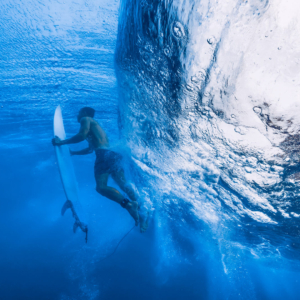
2 Comments